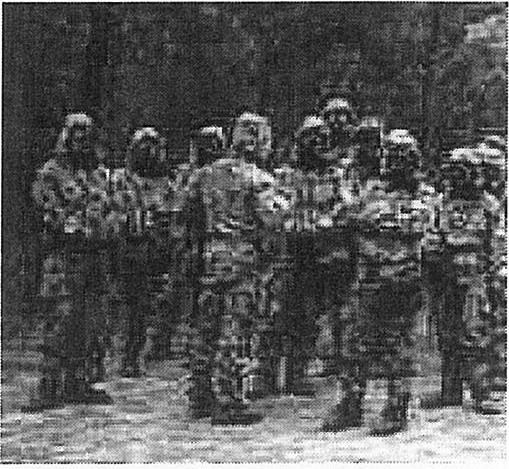Introduction
CS is the generic name for the lacrimating agent 0-chlorobenzylidene malonitrile (2- chlorobenzalmalonitrile). which was originally developed in 1928 by B.B. Corson and R.W. Stoughtonl.2. CS is normally a solid, which is disseminated either dissolved in a solvent liquid (acetone, methylisobutylketone or methylene chloride) or in a particulate form as a smoke.1 The latter is the more usual form used in training in the military.
Brooks first described Reactive Airways Dysfunction Syndrome (RADS) in 1985, principally after high level exposures to respiratory irritants3. The American College of Chest Physicians outlined a series of criteria, based on Brooks’ criteria, for the diagnosis of RADS. These were.
- Documented absence of preceding respiratory conditions.
- Onset of symptoms after a single exposure incident/accident.
- Exposure to an irritant gas (smoke, fume or vapour) in very high concentrations.
- Onset of symptoms within 24 hours of exposure, with persistence of symptoms for at least 3 months.
- Symptoms simulate asthma, with cough, wheeze and shortness of breath.
- Airflow obstruction on Pulmonary Flow Tests and/or presence of non-specific bronchial hyper-responsiveness
- Other pulmonary diseases ruled out.
Ripen et al.5 have also described a ‘low-dose’ or ‘low-level’ RADS associated with repeated low dose
exposures to irritants. This was also observed by Tarlo and Boder in their review of irritant-induced occupational asthma6.
Given the use of CS for mask test training in the military (Figure 1). There has been concern that CS may produce RADS in succeptible Australian Defence Force personnel. This brief paper will review the literature and the documented association between CS and RADS.
CS Effects
CS causes local irritation at concentrations of 2- 10 mg/ m3 and 10-20 mg/m3 is sufficient to disable an average sized adult1,7. The LCT50 is > 50,000 mg.min / m3.2 Normal military training exposure may produce rhinorrhoea, sneezing and choking, as well as skin and ocular symptoms. Known asthmatics are excluded from training with CS as CS exposure has been reported to exacerbate bronchoconstrictions. Pulmonary oedema and pneumonitis (in an infant) have been reported after exposure to very high doses of CS8.

Figure 1: Preparing for mask-testing
RADS
A review of the medical literature has shown only two cases of RADS and one case of low level RADS associated with exposure to CS. Hu and Roth both describe single cases where, on exposure to CS, the patients developed acute and immediate asthma, which persisted for several months after the initial incident9.10. Bayeux-Dunglas describes a case of low-level RADS, which developed after several exposures to CS11. A fourth case, described by Hill8, of a delayed case of asthma and possible RADS post CS exposure is associated with a hypersensitivity reaction and eosinophilia. As such, this case does not meet the original or revised criteria for RADS3.4.
Conclusion
CS is used extensively for training purposes in the military, police and prisons, both in Australia and overseas. CS also has been intensively used for riot control. Given the hundreds of thousands to millions of personal exposures over the last 15 years, the development of RADS from CS exposure is a possible but extremely rare consequence. Training Defence personnel to be confident in putting on and wearing their protective masks is a critical skill that is difficult to develop outside a mask testing facility or by other means. The highly remote risk of developing RADS as a consequence of such exposure is far from sufficient grounds to advocate cessation of such training. As with all training, a risk management approach should be adopted. If such an approach is adopted, the risk of this condition would be negligible and no further action should be taken.






